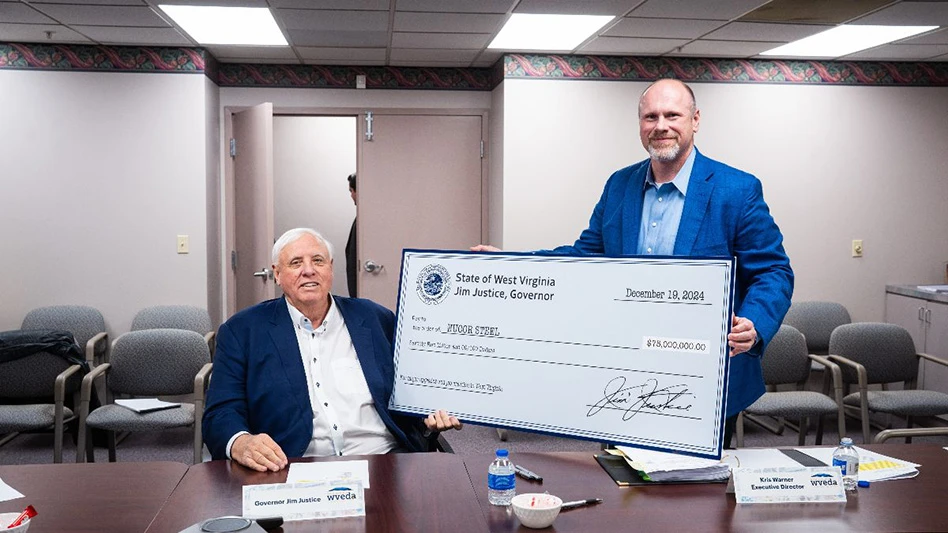Times are good for secondary commodities. Scrap steel, nonferrous metals and recovered paper are enjoying some of their strongest markets—and fetching some of their highest prices—in recent memory. The high times are spilling into emerging markets like recycled tires as well.
"When we look at the market, we see that the market for tire-derived materials, for recycling, is very, very robust from economic, environmental and political standpoints," says Anthony Cialone of Lehigh Technologies, a Naples, Fla.-based consumer of crumb rubber that produces a fine powder designed for reuse in the manufacture of new tires and other products.
Tire-derived fuel is still one of the biggest consuming markets for recycled tires, however, other end markets are gaining ground as the industry grows more sophisticated, including manufacturing powders like the kind Lehigh produces, as well as rubberized asphalt for road building, material for playgrounds and athletic fields and rubberized mulch.
"Companies are looking for solutions for their scrap that have positive environmental impacts," Cialone says. "Overall, the markets are very good."
FEELING THE BURN. Although it represents a lower-value end use, tire-derived fuel (TDF) is still one of the strongest markets for recycled tires,
PROVEN METAL Another facet to the growing sophistication of the scrap tire industry is how the business approaches the scrap steel found in tires. High scrap metal prices have changed the way some processors approach their business, says Troy Hess of Liverpool, Pa.-based tire processor Mahantango Enterprises. Wire has gone from a waste product to a revenue generator. "That’s definitely changed our industry," he says of soaring scrap metal prices. "You’re seeing more recyclers get more steel out of the rubber. There’s a lot [more] tire wire generated and recycled today than ever before. That’s a positive today instead of a negative." Anthony Cialone of Lehigh Technologies, Naples, Fla., a company that uses crumb rubber from recycled tires to make a powder material for use in manufacturing new tires and other products, agrees, adding that the increasing presence of mini-mills that rely on recycled material as feedstock has also contributed to the increased emphasis on recycling scrap steel tire wire. "Tire recyclers have gotten more sophisticated about scrap steel quality and are able to deliver scrap steel of sufficient quality that these mills can use," he says.
and today’s business conditions have had a dramatic impact on the demand for TDF.
"There’s no question that rising fuel costs are improving our markets," says Troy Hess of Pennsylvania-based tire processor Mahantango Enterprises and an ISRI Scrap Tire Processors Chapter officer.
Michael Blumenthal of the Washington, D.C.-based Rubber Manufacturers Association agrees. "TDF is the strongest market right now, plain and simple," he says. "Increases in energy costs, natural gas in particular—and coal—have made TDF very attractive."
However, Blumenthal says while in many areas of the country, TDF producers can barely keep up with the demand for TDF, other regions are weak. "It’s not evenly distributed around the country," he says. "Strong TDF markets are in New England and areas in the Southeast and some in the Southwest. But there are places around the country where you don’t have that kind of industry infrastructure, where you don’t have pulp and paper mills or cement kilns in a given region, and that makes the markets in the areas that don’t have that type of infrastructure a little bit weaker."
TDF accounted for about 155 million scrap tires in the United States in 2005, according to a report issued by the Rubber Manufacturers Association, about 52 percent of the scrap tires generated that year. Although it dominates more than half of the consuming market share, applications as an alternative fuel are not the only growing markets for recycled tires. Cialone says as the market matures, an increasing amount of recycled rubber from tires is being consumed by higher-value end products.
FROM THE GROUND UP. Hess says the market for recycled rubber used in athletic fields is growing, as the product has proven more durable than traditional grass or turf playing fields. "They put down this surface that has artificial blades of grass and fill it with crumb rubber," Hess says. "It brings more longevity—a grass field will wear away, but this is going to last and last. It’s very resilient and has a lot of cushion too it, so there’re less injuries from impacts on the joints."A reputation for longevity has also boosted demand for rubber mulch products, Hess adds. Gary Giller of Brooklyn Heights, Ohio-based GroundScape Technologies, which makes landscape material and
MEASURE AIMS TO ELIMINATE SCRAP TIRE STOCKPILES IN PENNSYLVANIA A bipartisan group of Pennsylvania lawmakers is seeking to eliminate scrap tire stockpiles across the state with legislation that provides $15 million in cleanup funds throughout five years. The Rubber Manufacturers Association (RMA) says it strongly supports the effort. The group conservatively estimates that Pennsylvania has nearly 8 million tires in stockpiles and is one of seven states that have more than 85 percent of the nation’s stockpiled scrap tires. The RMA, which represents tire manufacturers, says it is an advocate for effective scrap tire management programs and activities. The legislation, SB 1050, was introduced by state Sen. Lisa Baker (R-Dallas) with 11 co-sponsors, including Senate Minority Leader Robert Mellow (D). The measure would provide a $3 million annual appropriation for five years from the state’s Recycling Fund to the Used Tire Pile Remediation Restricted Account (UTRRA). The legislation would provide a consistent and dedicated source of funding for scrap tire stockpile abatement. Additionally, it would require the Pennsylvania Department of Environmental Protection to provide the legislature with an annual progress report on stockpile abatement activities.
playground cover from shredded recycled rubber, says those markets are experiencing high rates of growth recently, even taking away market share from its wood chip competitors. "People recognize the value of it," Giller says of rubberized landscaping material. "It’s very low-maintenance and a safer product. It’s relatively new, but people are starting to get educated."
While the market varies regionally, recycled tires are also finding increasing outlets for use in rubberized asphalt in road building applications, Blumenthal says.
Tire recycling as an industry is growing, says Cialone, and not just in size, scope and the numbers of companies engaged in the processing or consumption of material. He describes an industry growing in sophistication and maturity, which means as time goes on, more growth opportunities are going to crop up in higher-end use markets, the kind of remanufacturing product that represents closed-loop recycling. "It’s indicative of an industry that’s really trying to mature itself," he says. "We’ve got to have a vision of higher-value uses. The industry needs to mature and become a true recycling industry for tires."
Cialone sees the industry following other secondary commodities like steel, paper and plastics as far as providing feedstock for the manufacturer of new products from recycled tires. "We need to be able to use this material in a very high-value application," he says. "That’s where you get the most bang for your buck."
A number of factors are driving the industry in this direction, Cialone says, including the green movement.
NEW HEIGHTS. Many things have changed in recent years, meaning that the tire recycling industry of a decade ago is not the business seen today, Cialone says.Ten or 15 years ago, Cialone says oil was cheaper and people had a different perception of recycled or "green" products as somewhat inferior. "Those dynamics have changed," he says.
"Oil is expensive," Cialone continues. "It’s now more cost-effective to use recycled materials. Customers also now want green materials—they expect them to perform equal to, if not better than, virgin materials. In fact, companies that are perceived to be ‘green’ are seen as superior in quality."
Giller says the greening of the culture has been a boost to his business, selling to a more environmentally conscious group of buyers. "There’s a lot of momentum," he says. "Three years ago, we were educating the public, but now, the public is educated already."
Improved technology is also helping tire processors make a cleaner, higher-quality product. At the same time, Blumenthal says, today’s tire recyclers and processors have the industry know-how to better manage their systems to create better products. "This is still an evolutionary industry," he says. "We are way beyond where we were. We’re seeing second, third and fourth generation processing systems that are not just faster, not just bigger, but more efficient. On the other end of the equation, you’re seeing managers of these systems who’ve been in the industry long enough to have the management skill set to produce a higher-quality product."
These factors contribute to recycled tires’ growing presence as a true saleable commodity, even with lower-value end uses like TDF, Blumenthal continues. "It’s now the market working," he says. "This is where we always wanted TDF to be—a commodity. We’re institutionalized as a fuel, not just a substitute. Fifteen years ago, what we heard was ‘Hey, we’re doing you a favor taking this waste product off your hands.’ We don’t hear that today."
Where TDF has earned a place among its competitor products, higher-value end uses will follow, Cialone says. "Over time, as the processes of separation becomes more mature and the standard perfected, you’ll see higher and higher uses for these types of products," he says.
The author is associate editor of Recycling Today and can be contacted at jgubeno@gie.net.

Explore the October 2007 Issue
Check out more from this issue and find your next story to read.
Latest from Recycling Today
- IDTechEx sees electric-powered construction equipment growth
- Global steel output recedes in November
- Fitch Ratings sees reasons for steel optimism in 2025
- P+PB adds new board members
- BlueScope, BHP & Rio Tinto select site for electric smelting furnace pilot plant
- Magnomer joins Canada Plastics Pact
- Out of touch with reality
- Electra names new CFO





